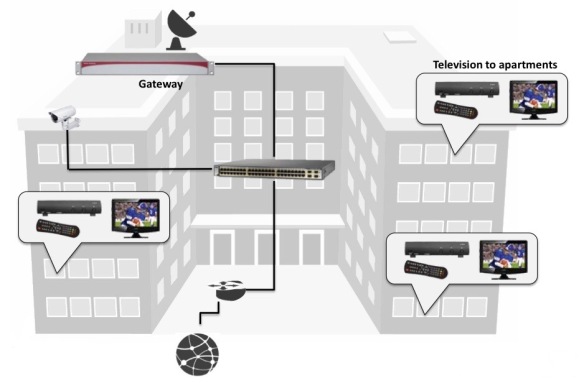In April, 2014, I was awarded my first US Patent. It’s a goal of most engineers, to discover or invent something worthy of a patent. I was pleased to achieve this when the US patent authority issued US 8,707,370 to me.
The minute details are here. It’s written in patent-speak and a tough slog even for me, so allow me to translate and tell you what this is for and why it matters.
How it works
Most of us have received TV in one or both of the two conventional ways: cable or satellite. Many of us have a choice in provider – albeit a limited choice. But what if you live in a condominium like my beloved parents? As a condo tenant you’re usually not allowed to mount unsightly satellite antennas on your balcony railing. Instead, Multiple Dwelling Units (MDUs) are typically pre-wired for cable TV. This leaves the tenant with no choice for their TV provider other than to subscribe to the cable routed into their apartment.

Increasingly newer developments and renovated MDU complexes are being fitted with Ethernet networks—the wiring with connectors that look like over-sized telephone jacks.
This enables a new type of TV service provider option – IPTV. Bell’s relatively new Fibe-TV offering uses IPTV technology and is already available to many urban homes. Thus a typical urban home now has three mainstream choices to receive TV: cable, satellite, and IPTV.
Back to MDUs. If an MDU has been retrofitted with Ethernet cabling, a new localized IPTV service may be deployed in the MDU by utilizing a multi-service satellite receive solution called a satellite Gateway. The Gateway translates the satellite TV services into IPTV services and forwards these onto the local MDU Local Area Network (LAN). In the tenants’ apartments, the IPTV services are readily accessed using authorized receivers, Set Top Boxes (STBs).
Here’s an example:
 The Gateway in this case is housed in an equipment room near the roof of the MDU for convenient proximity to a satellite antenna. The Gateway receives all the TV services available from a particular satellite TV provider such as the Bell TV or the Shaw Direct services. The Gateway converts all the services into a format suitable for broadcast on the Ethernet network in the MDU (basically by wrapping up the satellite services into multicast IP streams).
The Gateway in this case is housed in an equipment room near the roof of the MDU for convenient proximity to a satellite antenna. The Gateway receives all the TV services available from a particular satellite TV provider such as the Bell TV or the Shaw Direct services. The Gateway converts all the services into a format suitable for broadcast on the Ethernet network in the MDU (basically by wrapping up the satellite services into multicast IP streams).
Tenant apartments would have a TV and a Set Top Box (STB) with remote control. The STB can receive all the services on the Ethernet network as made available by the Gateway. All a tenant needs to do is contact the service provider and subscribe to an appropriate TV package. The service provider then authorizes that tenant’s STB for the subscribed services.
The beauty here is that the service provider can use all the same back-office applications and procedures (billing, conditional access) for this new subscriber as they do for their regular satellite subscribers since the encryption of the services is passed through the Gateway all the way to the STBs.
The Patented Part
So where does my patent fit into all of this? Well needless to say there are a lot of technical things going on in this system to make it all work. In all this complexity is the need for the Gateway to make known to the STBs exactly what services are available and how to access them in the Ethernet network. This traditionally has involved the use of complex protocols of communications between all the STBs and the Gateway. Since there are frequently many different equipment manufacturers involved in the deployment of such a system, each vendor needs to implement these protocols and since they are complex, it takes a lot of time and money.
This is where my patent comes in. The patent defines a simple method for the Gateway to tell the STBs how to access the services on the Ethernet network. Since it is simple, it is easy for all the equipment manufacturers to implement. Ease of implementation lowers the barriers-to-entry for manufacturers and this translates into lower costs for the equipment and a quicker time to market for the whole service.
In one ideal business model, STB manufacturers would pay a license fee to the assignee of my patent, International Datacasting Corporation (IDC), for the right to implement the patented protocol in their equipment in order to be compatible with IDC’s Gateway product.
And there you have it—an explanation of my patent and how it can be used to bring more choice to consumers and more efficient solutions to service providers.
